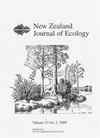奥克兰岛野猫的监测和检测
IF 1.4
3区 环境科学与生态学
Q3 ECOLOGY
引用次数: 9
摘要
为了保护重要的生物多样性价值,计划在新西兰亚南极地区的奥克兰岛消灭野猫。这一消灭将需要详细了解岛上猫的数量、分布、运动行为和发现概率。我们在该岛北端的一个半岛上调查了这些参数,使用了现场诱捕、相机诱捕和带和不带探测犬的粪便搜索。在这里,我们比较了这些方法的结果,并讨论了它们对计划根除的效用。四只猫被捕获并安装了GPS项圈。间隔500米的相机陷阱在多个场合和多个地点检测到所有这些个体。摄像机还捕捉到了至少12个人。排除每第二个摄像头(模拟1000米间隔)导致无法检测到32%的已知个体。通过相机捕捉估计的种群密度在0.7-1.0只猫/平方公里之间变化。人类发现了29个猫粪,狗发现了33个。基因分析估计这些基因来自至少10个个体。在消灭行动和确认阶段应重复使用摄像机诱捕,以监测猫密度的时空变化,发现幸存者,并帮助确认消灭成功。收集粪便,不管有没有狗,都可以补充相机捕捉的数据。随着猫的样本量增大,DNA分析也可以用来估计猫的丰度。本文章由计算机程序翻译,如有差异,请以英文原文为准。
Monitoring and detection of feral cats on Auckland Island
: In order to conserve important biodiversity values, eradication of feral cats ( Felis catus ) is planned on Auckland Island in the New Zealand subantarctic region. This eradication will require detailed knowledge of the abundance, distribution, movement behaviour and detection probability of cats on the island. We investigated these parameters on a peninsula at the northern end of the island using live trapping, camera trapping, and scat searches with and without detection dogs. Here, we compare the results of these methods, and discuss their utility for the planned eradication. Four cats were captured and fitted with GPS collars. Camera traps with 500 m spacing detected all these individuals on multiple occasions, and at multiple locations. At least 12 other individuals were also captured on camera. Excluding every second camera (to simulate 1000 m spacing) resulted in failure to detect 32% of known individuals. Population density estimates from camera trapping varied from 0.7–1.0 cats km -2 . Humans found 29 cat scats, and dogs found 33. Genetic analysis estimated that these came from a minimum of ten individuals. Camera trapping should be repeated during the operational and confirmation phases of the eradication to monitor spatial and temporal variation in cat density, detect survivors, and help confirm eradication success. Scat collection, with and without dogs, can supplement data from camera trapping. With larger sample sizes of scats, DNA profiling may also allow cat abundance to be estimated.
求助全文
通过发布文献求助,成功后即可免费获取论文全文。
去求助
来源期刊

New Zealand Journal of Ecology
环境科学-生态学
CiteScore
3.00
自引率
12.50%
发文量
35
审稿时长
>36 weeks
期刊介绍:
The New Zealand Journal of Ecology is a biannual peer-reviewed journal publishing ecological research relevant to New Zealand/Aotearoa and the South Pacific. It has been published since 1952 (as a 1952 issue of New Zealand Science Review and as the Proceedings of the New Zealand Ecological Society until 1977). The Journal is published by the New Zealand Ecological Society (Inc.), and is covered by Current Contents/Agriculture, Biology and Environmental Science, GEOBASE, and Geo Abstracts.
 求助内容:
求助内容: 应助结果提醒方式:
应助结果提醒方式:


